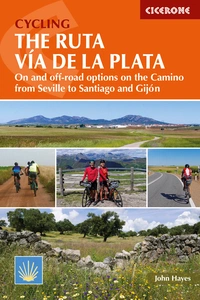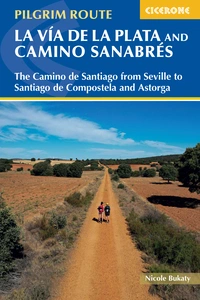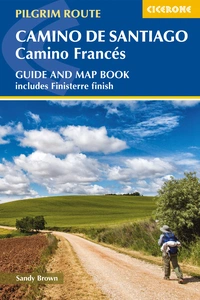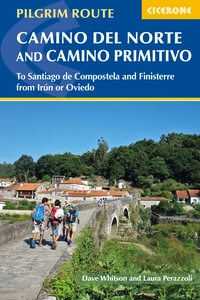Timmy Mallet – cycling the Ruta Via de la Plata
When a small window of opportunity opened up to go on a cycle trip, Timmy Mallett and his friend Gary decided to explore the mysterious Camino de Santiago in Spain.
It started with a box of dominoes; the perfect game for a cycling adventure, when you want something easy after a day in the saddle. It’s a simple game, and a good ice breaker with fellow travellers.
Me and my companion Gary picked up a set at Madrid station and played it on train to Seville, in the bars with tapas, and each evening after a hard day’s pedalling along the Camino de Santiago Via De la Plata. Out came the dominoes and people around us joined in.
Cycling the Ruta Via de la Plata
On and off-road options on the Camino from Seville to Santiago and Gijon
£16.95
Guidebook to cycling the Ruta Via de la Plata through western Spain, covering the 924km route from Seville to the coastal city of Gijón and a pilgrimage variant to Santiago de Compostela. With road and off-road alternatives (the latter suitable for gravel bikes), the route offers fantastic cycling and rich cultural and historical interest.
More informationAll routes lead to Santiago
There are dozens of different Camino routes to Santiago de Compostela – the burial place of St James the Apostle – and people have been heading there for over 1000 years.
The Via de la Plata is the main 1000km southern and western route across Spain from Seville to Santiago via southern Galicia. Some choose to start on the coast at the grand port city of Cadiz and the Camino goes on to pick up other pilgrims from different start points along the way.
At Zafra we met pilgrims from the Camino del Sur. At the ancient Roman gem of Merida we were joined by those on the glorious Moorish trail from Malaga and Granada known as the Camino Mozarabe.

Further on, in Zamora, you meet travellers from Toledo and Valencia on the meandering Camino Levante.
The attraction of the Via de La Plata lies in its marked change of landscapes from the deep Mediterranean southern plains through to the mountains of Castille and Galicia in the north (while bypassing the Spanish capital Madrid).
It’s noticeably different, and actually longer, than the popular Camino Frances from the foot of the Pyrenees.

So with barely a week to go exploring, just time for a taster of the route, we booked cycle hire, baggage transfer and accommodation with a travel company.
From Madrid we headed across the country on the high speed train to Seville (where we had a little mix up, with the mountain bikes delivered to the wrong hotel), and in five days managed to cycle perhaps a third of the Via de la Plata up to the attractive walled town of Caceres.
The rain in Spain

Our travel window was late March, and we were expecting it to be warm and dry… but we didn’t take into account that the rain in Spain falls mainly on the plain and we were clearly on the plain!
Seville is a stunning tourist city, especially in early springtime. The cobbled city centre streets echoed to the clip clop of horses hooves pulling tourist carriages and the delightful tiled shops and cafés were bustling with people, sheltering from the stormy weather.
We were there in Holy Week and the region was ready to celebrate. Starting alongside the cathedral we searched for the tiny blue-tiled Camino de Santiago shell and arrow sign and pedalled off across the bridge through the gardens of wisteria.
Following the camino signage out of the city can be tricky, but the cycling is easy and fragrant along roads lined with Seville oranges trees; and we headed out into open farmland along wide, flat tracks where storks wheel on the thermals and nest on top of electric pylons.
That March, Spain had endured twice the usual rainfall so when we came to the wide ford across the river we had to take off our shoes and socks to pedal the 100 metres or so in the fast-flowing torrent.
And then suddenly it was up to our knees! Wooo! But the second ford was shorter – and deeper – and as it reached our thighs we backed out.
In the guide book there was a small detour to find an alternative way across the river, but the conditions defeated us and instead we struggled back some way to the tarmac and searched for a garage forecourt to wash the thick, glutinous mud off the sorry bikes.
We’d been tempted by the description of flat, simple riding and by and large it is apart from that first day, which ended with the long slow 15km hill up to our hotel in the dark.
Challenges
There were certainly challenges on this trip – punctures, malfunctioning brakes and an emergency repair just before Good Friday when everything closed for the long weekend. A new back wheel, new brakes, new chain, new sprockets and a sizeable bike bill later, and we were on our way.
Undeterred, things improved. When it didn’t rain, it was marginally warmer than our chilly British winter.
Along our route olive groves were carpeted in spring flowers, then there were vast meadows of purple lavender, followed by sweet-smelling eucalyptus trees.
Poppies bloomed, vineyards were tended, the cafés were full of happy locals playing two up and dominoes, a good excuse to join in.

It was the beginning of the season and few pilgrims were venturing out. Most days we’d pass barely a handful, but the welcome was always warm and familiar and our meetings always delivered a conversation. Where are you from? Where are you headed? Buen Camino!
We needed to keep our eyes peeled for the famous, distinctive yellow camino shell signage. Sometimes, it’s hard to spot in the long grass or high on a street wall, and we quickly learned to take refreshment where we could.
The village cafés always offered delicious tortilla, and our evening meals of Spanish tapas, seafood and the staple menu peregrino/pilgrim menu meant we were well fed and welcomed.
You can’t miss the local wines, either – at the entrance to most towns, we often came across giant statues of wine bottles reminding us that this is wine country and to try the local grape.
Every camino route is a different adventure. There are a raft of history connections on the Via de la Plata from the Islamic Iberian empire, to the much more visible Roman infrastructure from the earlier age of Empire.

My companion Gary chose to ride the tarmac, while I preferred the off-road farm track camino, although the weather conditions made it challenging. Either way you leave stones on the waymarkers and tie ribbons to mark your passage.
We followed the old Roman Road up past 2000-year-old remains of theatres and stadiums, bridges, reservoirs and at Merida the outstanding huge double-decker Roman aqueduct. This is infrastructure that was built to last.
I took my watercolours with me and I’m pleased to say the inspiration has found its way into my camino series of work that you can see at www.mallettspallette.co.uk The painting ‘Hard at Work’ is based on the chance meeting with the elderly man collecting olive branches to heat his home. Life isn’t always easy, but that little exchange always reminds me that there is dignity in honest work well done.
Semana Santa
Semana Santa – Holy Week – was a real bonus. This is when Spain gets festive, with nightly processions of the church statues around the towns, and I mean every town.
At 1am we watched the resurrection procession with the whole town cheering and clapping as statues of Christ in his loin cloth were carried through the streets with the Virgin Mary. It’s a reminder that this is an ancient pilgrimage route.
The local bands play the same haunting tune, and the sturdy townsfolk carry the statues on floats on their shoulders; choreographed by secret tapping to tell them whether to turn, to go straight on or stop and sway.
It looks stunning in the candlelight and they are led by the penitents who look mysterious in their tall, pointy hats (known as capirotes) and their faces covered in white, black, purple or blue. Very strange and very Spanish.
Sadly, the Ku Klux Klan commandeered this look in the US and we needed to look past the association. The Caceres museum has a good display explaining the history of these strange costumes and their significance, which date back to the days of the Inquisition.
These processions are watched by thousands every night and covered in detail live on television.
Ending our adventure after five days without reaching Santiago was in some ways a disappointment. In others it was a taster and a catalyst to attempt this adventure again properly. By this I meant pedalling the Camino from home across the pilgrim routes of England, France and Spain there and back – a distance of 3750km.
The Camino de Santiago – the Way of St James - is a thought provoking experience; and each route to Santiago is different. It varies through the time of year, the route you take – you can start from dozens of different spots, but one thing never changes.
You will be at the mercy of the elements. Expect baking hot in the summer and rain in the spring and autumn. So take a sense of humour, a sense of wonder and a set of dominoes.
All photos © Timmy Mallett
You can read more about this in my book Utterly Brilliant – My Life’s Journey published by SPCK and available in hardback, paperback, Ebook and audio book. www.timmymallett.co.uk
Mallett Fine Art including my camino series at www.mallettspallette.co.uk












